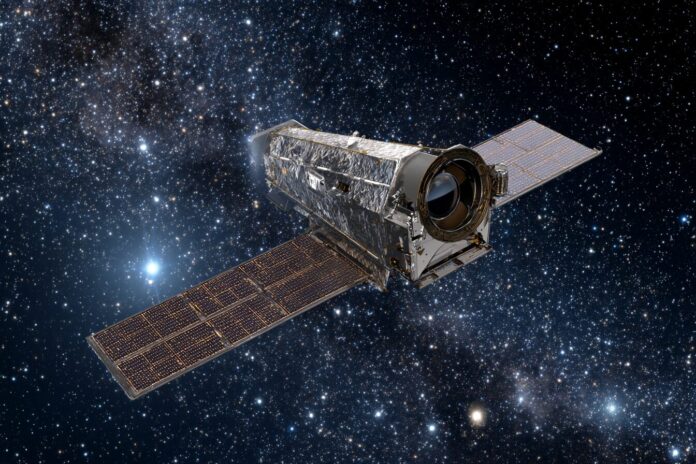Unlocking the Universe: Roman’s Bold Mission
The Nancy Grace Roman Space Telescope is poised to revolutionize modern astronomy. Set for launch in 2027, this mission is a landmark in cosmic exploration. Roman is designed to capture about 100,000 cosmic explosions in just two years, surpassing every previous survey in both scope and speed.
Because this telescope will peer deep into the universe, its survey is expected to redefine our understanding of everything from stellar explosions to the universe’s expansion. Most importantly, the mission emphasizes both precision and innovation. Astronomers are particularly excited due to its potential to record phenomena that have never before been observed, which may even challenge our current scientific models. Additional insights can be found at ScienceBlog and Daily Galaxy.
The High-Latitude Time-Domain Survey: A Cinematic Approach to Astronomy
At the heart of Roman’s operations is the High-Latitude Time-Domain Survey. This strategy involves scanning the same expansive area of the sky every five days over a span of two years. By doing so, Roman will create a series of dynamic time-lapse images that document the changing universe. These fascinating sequences will resemble cinematic films, capturing events that span billions of years.
Besides that, the novel survey method offers scientists a real-time view of explosive events. Constant monitoring ensures that even short-lived phenomena are not missed. Transitioning from static images to dynamic movies enhances our understanding of stellar behavior. Such a method not only makes science visually engaging but also enriches the data available for analysis. For further details, visit NASA’s official page.
Supernovae: The Universe’s Measuring Sticks
Astronomers eagerly anticipate Roman’s capacity to record nearly 27,000 Type Ia supernovae—a record nearly ten times higher than previous efforts. These cosmic explosions are crucial because their peak brightness remains consistent, which makes them reliable “standard candles” for calculating astronomical distances. Because of their consistency, these events help us chart the expansion of the universe.
Moreover, Roman is expected to detect thousands of these supernovae dating back over 10 billion years, with some sightings potentially reaching as far as 11.5 billion years into the past. Such detailed timelines offer rare insights into cosmic history and will help scientists refine models of cosmic evolution. The systematic capture of these events ensures that even subtle variations in brightness can be measured accurately.
Probing the Mystery of Dark Energy
Beyond documenting cosmic explosions, the Roman Space Telescope plays a pivotal role in exploring dark energy—the mysterious force driving the acceleration of the universe. By charting these explosions across vast time and space, scientists can better gauge how dark energy has influenced cosmic expansion over billions of years. Therefore, Roman’s dataset will be invaluable for testing theoretical models and enhancing our understanding.
Because the telescope will provide an unprecedented volume of high-quality data, astronomers expect significant breakthroughs in unraveling dark energy’s properties. Its comprehensive survey may even shed light on whether the intensity of dark energy has evolved over cosmic time. More fascinating perspectives on this topic can be read at Supercar Blondie.
Beyond Supernovae: An Explosion of Discovery
While Type Ia supernovae dominate the headlines, Roman’s expansive survey goes far beyond these events. The telescope is expected to capture a diverse range of phenomena, including the explosive deaths of massive stars, energetic outbursts near black holes, and even the first generation of stars that ignited more than 11 billion years ago. Most importantly, these observations promise to fill many gaps in our cosmic narrative.
In addition, the broad sweep of Roman’s survey may uncover events that defy current classification. Because of its expansive view and sensitive instrumentation, many discoveries are expected to be completely unexpected. Consequently, this diversity of observations will drive new theories and inspire fresh questions about the universe’s nature. Interested readers can learn more at Universe Today.
Revolutionizing the Future of Time-Domain Astronomy
Roman is not just another telescope; it is a leap forward in time-domain astronomy. By repeatedly observing the same regions over time, Roman provides scientists with a unique perspective on how celestial events unfold. This approach transforms static snapshots into living sequences, enabling a dynamic study of the cosmos.
Because each observation is made in quick succession, the telescope captures transient events that typically go unnoticed. These high-frequency observations allow for comparative studies of stellar evolution, black hole activity, and galaxy formation in near real-time. Therefore, Roman’s mission will fundamentally reshape our methods of astronomical research, delivering results that are both groundbreaking and highly detailed.
Conclusion: The Promise of the Unexpected
In summary, the Nancy Grace Roman Space Telescope represents a new era in cosmic discovery. Because it will capture a monumental number of cosmic explosions, Roman is set to answer long-standing questions about dark energy and the expansion of the universe. Equally important, it will introduce us to phenomena that have never been imagined before.
Most importantly, the telescope’s innovative survey and time-lapse techniques will not only advance our scientific knowledge but also inspire future generations of astronomers. With each new observation, we stand to learn more about our universe and the surprising events it hosts. The excitement remains palpable as the world eagerly awaits Roman’s breakthroughs, ready to embrace a realm of the unexpected.
References:
ScienceBlog
Daily Galaxy
NASA
Universe Today
Supercar Blondie



